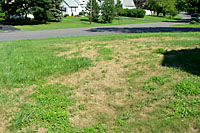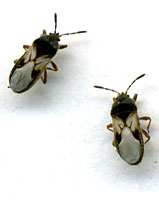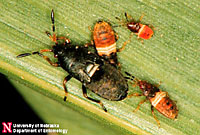Terry L. Ettinger Horticulture Consulting Services
Meeting The Needs Of Today With A Vision For The Future
Question of the Week
Chinch Bugs in Your Lawn
 Q. Something very weird is going on in our lawn. Even though we had a ton of rain last month, there's one spot that
looks like it's dying and it seems to be getting bigger over the past several weeks? We had problems with this general area
last summer, too, and reseeded it this past spring. Any idea as to what might be going on?
Q. Something very weird is going on in our lawn. Even though we had a ton of rain last month, there's one spot that
looks like it's dying and it seems to be getting bigger over the past several weeks? We had problems with this general area
last summer, too, and reseeded it this past spring. Any idea as to what might be going on?
A. Without more information - e.g., how big the spot is, is it in sun or shade, does the soil tend to be wet or dry soil, fertilization and mowing practices, etc. - it's impossible for me to say for sure what might be happening to your lawn. I have, however, been on several lawns during the past couple of weeks that were showing symptoms similar to those you've described - dead spots that were gradually increasing in size.
 What I discovered when I got down on my hands and knees and spread the grass plants apart were numerous tiny black and
white insects scurrying rapidly across the soil surface and burrowing into the underlying thatch among grass plants along
the edges of the damaged lawn areas. In some spots there were easily several dozen of these critters, hairy chinch bugs,
per square foot of lawn.
What I discovered when I got down on my hands and knees and spread the grass plants apart were numerous tiny black and
white insects scurrying rapidly across the soil surface and burrowing into the underlying thatch among grass plants along
the edges of the damaged lawn areas. In some spots there were easily several dozen of these critters, hairy chinch bugs,
per square foot of lawn.
Adult chinch bugs, like those above, are only about one-eighth of an inch long and survive our winters by burrowing down into the thatch layer of lawns. As the weather warms in late April they start mating and females then start laying eggs in hot, dry sunny lawn areas by mid- to late May.
 By late June
most of the eggs will have hatched and really tiny, orange-red colored nymphs (only a millimeter or so in length)
start feeding on the sugary sap inside of grass plants by inserting their mouthparts into the stems.
The University of Nebraska image at right shows several of the
developmental stages of chinch bugs. The youngest nymphs are less
than 1/16 of an inch long and are hard to see because they feed
inside leave blade sheaths at the base of grass plants.
By late June
most of the eggs will have hatched and really tiny, orange-red colored nymphs (only a millimeter or so in length)
start feeding on the sugary sap inside of grass plants by inserting their mouthparts into the stems.
The University of Nebraska image at right shows several of the
developmental stages of chinch bugs. The youngest nymphs are less
than 1/16 of an inch long and are hard to see because they feed
inside leave blade sheaths at the base of grass plants.
Damaged caused by chinch bug feeding in June and July plugs the vascular tissue of grass plants, preventing water from moving from the roots to the grass blades - regardless of how much rain may fall. This ultimately results in the death of infested plants and the nymphs then scurry to healthy grass plants nearby to repeat the process.
Over the course of a month or more, the migration of dozens to hundreds of nymphs from dying plants to healthy plants results in the gradual expansion of dead spots in sunny lawn areas that become especially apparent during hot, dry weather from late July into September.
To determine if chinch bugs are active in your lawn, you have a couple of options.
One is to simply get down on your hands and knees and start pulling grass plants apart in affected parts of your lawn during early to mid-afternoon and a sunny, warm day when chinch bugs are most active. Look very closely and be very patient as these little critters will initially scurry away from the disturbance. It can take even a trained eye several minutes to become accustomed to seeing the tiny insects as they race across the soil surface.
A second "scouting" technique is to cut the bottom out of a two pound coffee can and shove one end several inches into the ground right where damaged portions of your lawn meet what appears to be healthy lawn. Fill the can with water and wait ten to twenty minutes (refill the can if the water drains rapidly).
If chinch bugs are present, they'll float to the surface and will be relatively easy to count. If you count more than five chinch bugs, there's no question that the critters are likely the cause of your lawn's demise.
Unfortunately, undertaking this scouting process after the damage has become apparent only confirms the cause of the lawns decline. By the middle of August, the only option for managing lawns areas damaged by chinch bugs is to renovate/overseed as soon as possible.
To reduce future damage, mow and fertilize correctly to encourage vigorous growth of the reseeded lawn.